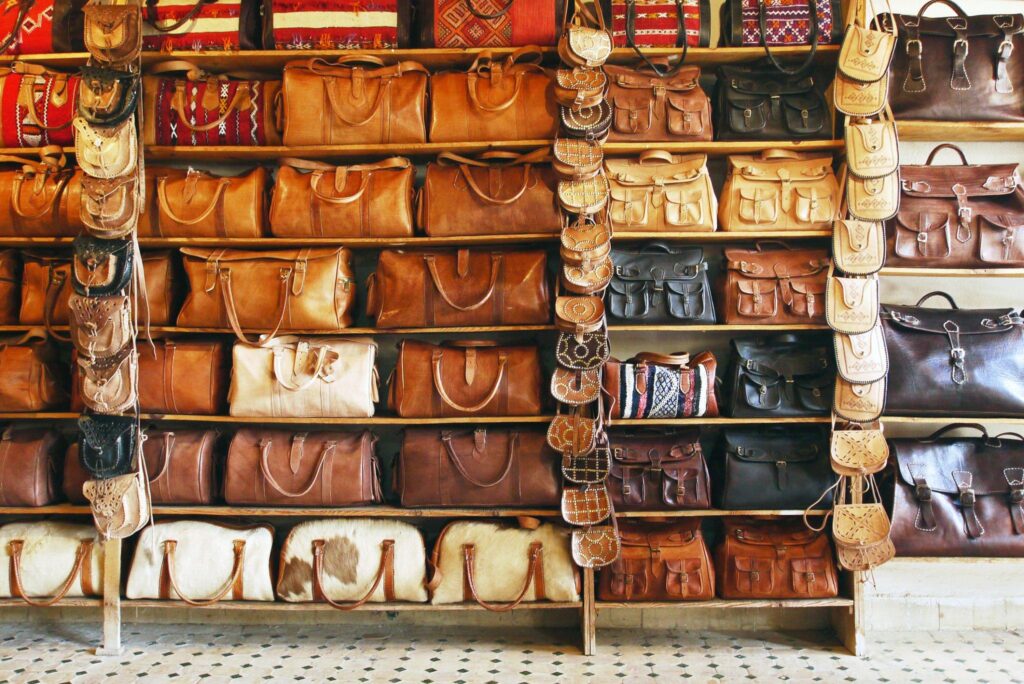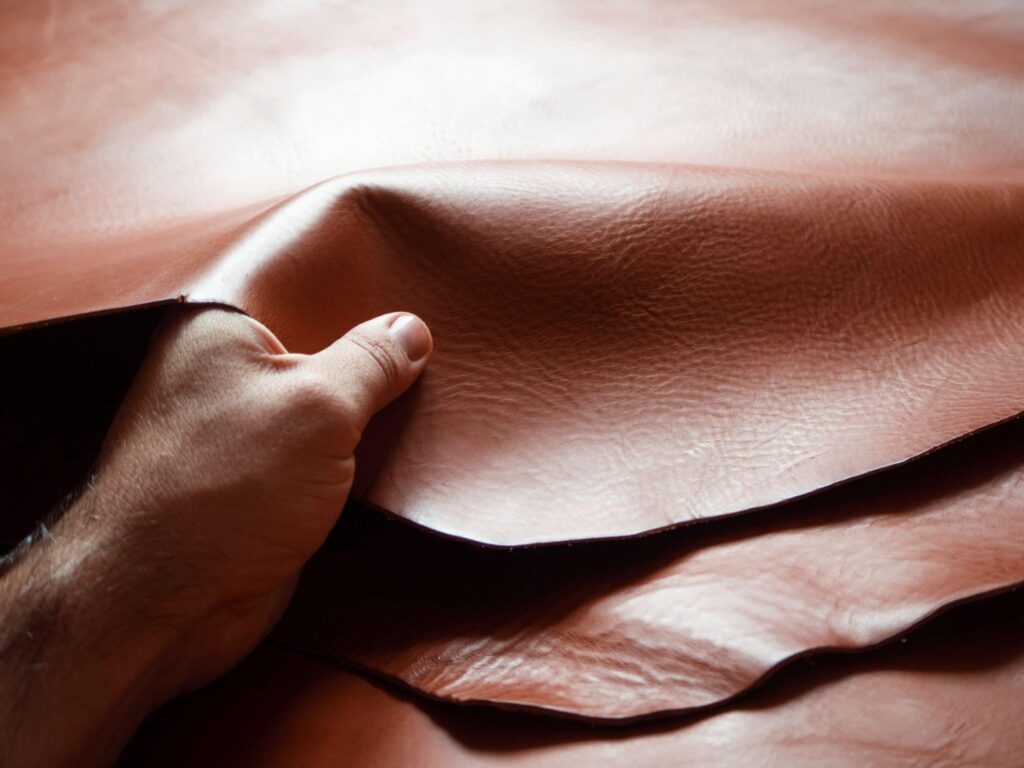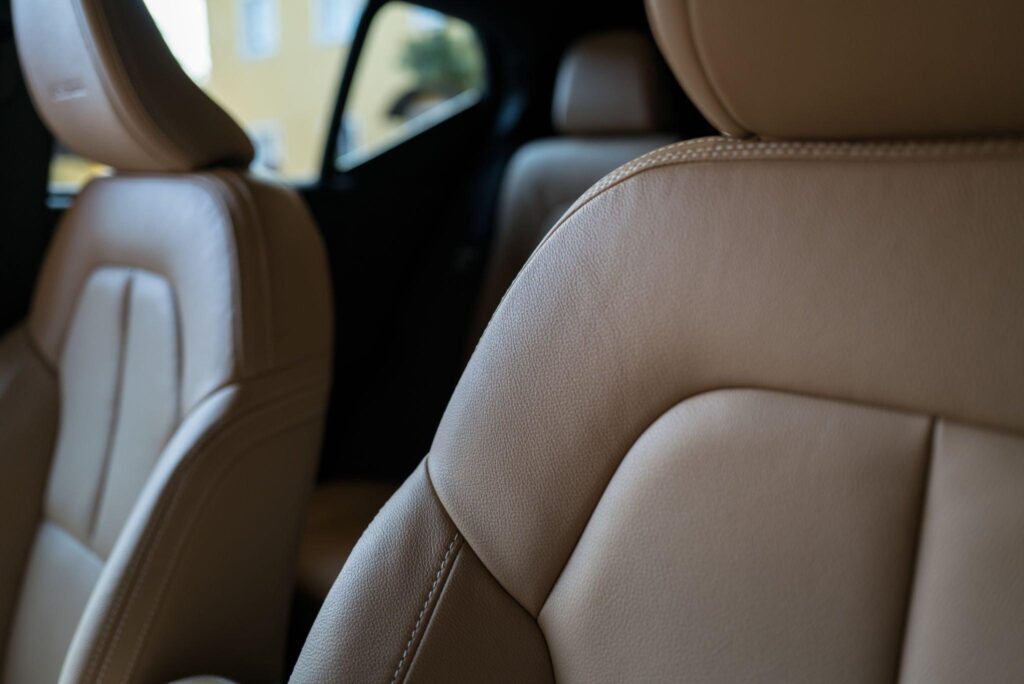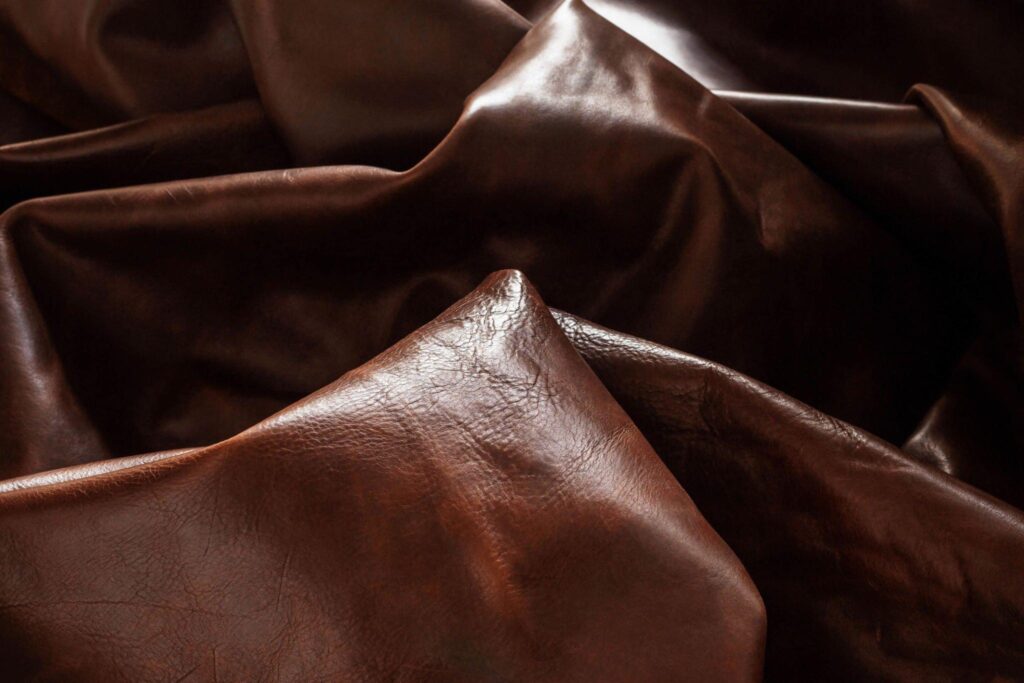Natural clothing is manufactured from tanned animal skin, leather, and others. Leather, which is claimed to have been the first fabric created by human hands, has seen significant evolution throughout history.
However, leather continues to be one of the most sought-after textile products due to its insulating properties, water resistance, luxurious softness, and durability. One of the most adaptable natural materials is leather, and different types of leather come in a huge variety of looks, quality levels, and colors.
How Are Leather Fabrics Created?
The skins of highly treated animals are used to make leather cloth. The preparation for tanning, tanning, and post-tanning processing are the three main steps in the production of different types of leather fabric.
Preparing For Tanning
A removed animal’s skin must first be fleshed, which is the removal of flesh and film from the back of the hide before it can be tanned into leather. The hide is then stretched and put through a dehydration procedure that includes air drying, salting, or pickling. This procedure is essential because once an animal’s hide has been removed from its body, it will quickly start to disintegrate.
Tanning
The chemical compound tannin (also known as tannic acid), which is present in the roots, bark, seeds, and several other portions of numerous plant species, is where the name “tanning” originates. However, nowadays, the majority of leather producers employ mineral tanning rather than vegetable tanning, which uses different kinds of leather called chromium III sulfate.
Leather producers soak hides in a solution of lime and water after they arrive at a tannery to help remove hair and other unwanted tissue. Then a machine takes these things away.
The skins are subsequently washed by leather makers to remove any remaining lime, and they are based, which is a color-boosting procedure that eliminates a non-fibrous protein. The hides are ready to be tanned after being pickled by leather makers as a final softening procedure.
Tanning After-Processing
After the tanning procedure is finished, the hides are properly dried before being colored with one of several various dyeing techniques. The surface of the skins is then treated with oils or greases by leather producers to make the finished product softer and more water-resistant.
The nearly finished leather is then dried by leather makers to a moisture content of about 15%, and is then raised, or “reconditioned,” to a moisture content of about 20%. The finished leather is stretched one last time and then given a final coating to make it weather and abrasion-resistant. The leather may now be used to create a variety of consumer goods.

How Many Types Of Leather Are There?
Understanding the many types of leather produced nowadays is essential for choosing which leather is best for any use or purchasing ready-made leather products. Here are some terms you should be familiar with before moving on to the various varieties of leather.
What Is The Difference Between Different Types Of Leather?
Superior leather differences are frequently more durable and slightly stiffer than imitation leather. Your top-grain and full-grain leather, however, will gradually supple and endure well. The volume of leather may also affect its thickness. As a result, some high-end leather may nevertheless be quite supple. Fake leather, however, tends to lose its structure and become weaker.
To discover if you have genuine quality kinds of leather, use the classic sniffer. It will smell like chemicals and plastic if the leather is fake or of low quality. In other words, real leather will smell like leather. (However, if the leather has been painted or dyed, be cautious of that scent.)
Leather grain types could contain a few minor flaws as well as an irregular grain pattern. If you look at the entire hide, high-grade leather will also have rough edges. Due to manufacturing, lower-quality leather will appear precisely homogeneous.

THE DIFFERENT TYPES OF LEATHER
Faux Leather
It is not real leather. It is synthetic leather produced from rubber-coated fabric and synthetic elements like plastic. Faux leather has greatly improved the material composition through technology, raising the levels of leather products. Although it is sturdy and resembles genuine leather, it is the most affordable kind of leather for furniture.
Drop a little water on the merchandise to tell real leather from fake since leather absorbs moisture. If it is faux leather, the water will only pool on top. Real leather, however, would take the moisture in.
Bi-cast Leather
The lowest layers of the hide, which are “split,” are used to create bi-cast leather. This bottom layer lacks strength and is either too thin or defective to be used normally. Furthermore, the natural beauty of the top-grain layer is absent from bi-cast leather. This layer is then covered with a layer of polyurethane, which is composed of paints, varnishes, adhesives, and foams, and is then embossed to resemble genuine leather.
The clothing manufacturers have the comfort characteristics of top-grain leather that are not present in bi-cast leather. For those who want the appearance of leather without the cost, it can still be a viable choice.
Compared to genuine leather, it is far less expensive and less sturdy.

Suede Leather
The inner side of the animal hides, which is visible on the underside of the leather, is used to create suede leather. Although any animal hide can be used to create suede leather, lamb, goat, deer, pig, and calf are the most popular. The best leather type of animal has an impact on how the suede is finished. To generate a thin, soft substance, the innermost, thinnest layer is removed.
Suede is more affordable than Nappa or Nubuck and is also fairly durable. However, it is difficult to clean and soon gets dirty.

The semi-aniline Leather
Semi-aniline leather has a small amount of color. This kind of leather treatment gives the material a thin layer of surface protection. The leather is shielded from scratches by this covering.
The added pigment uniformness the coloring of a semi-aniline finish, removing some of the natural characteristics of the leather. The leather would be shielded by the coating, but it would also be more difficult for it to breathe and develop a patina over time.

Antique-grain Leather
Ancient Grain Leather is a form of leather that has been treated to give it the weathered appearance of antique or vintage leather. It is also known as distressed leather.
The leather surface frequently has a contrasting top coat that is applied unevenly or only partially, revealing a light underlying hue. Most buyers are drawn to this worn-in appearance, particularly when looking at leather furniture and accessories.

Chrome-free Leather
Alternative tanning techniques including aldehyde tanning or vegetable tanning are used to create chrome-free leather. Many governments and tanneries have been forced to adopt these chrome-free tanning procedures because of the environmental damage caused by the chrome-based tanning process.
Nearly all of the characteristics of chrome-tanned leather, including greater shrink resistance, increased resilience, and greater flexural strength, are present in processed leather. Furthermore, the ecosystem is not being harmed by hazardous effluents.

Leather tanned in chrome
Instead of using vegetable tannins or chemicals containing aldehydes to tan the leather, chrome-tanned leather uses chromium salts (chromium sulfates).
Leather that has been chrome tanned is more flexible, robust, somewhat durable, and water resistant. To create leather with a variety of bright hues, use a selection of dyes. However, especially in underdeveloped nations, chrome tanning has extraordinarily high environmental consequences.
The toxic wastewater is frequently allowed to seep into the groundwater supplies and harm the land due to improper recycling practices. Additionally, due to its delicate nature, chrome leather is not appropriate for patterning and stamping.

Pigmented Leather
To achieve the intended appearance and properties, a polymer surface coating containing specific colors is applied. Pigmented leather is frequently used to create furniture and automotive upholstery due to its longevity.

Crust Leather
Leather made of the crust is tanned, and dried, but not colored. It is referred to as chrome crust or vegetable crust depending on the tanning procedure. However, dyeing is the final step before processing crust leather. It possesses all of the physical characteristics, such as size, thickness, fullness, grain looseness, and grain damage.
Embossed leather
Leather having artificial designs stamped on the animal skin’s natural grain using heat and high pressure is referred to as embossed leather. Typically, embossed leather is produced using steel plates with various engraved designs for several uses, including upholstery and accessories.
Blind embossing, gold embossing, and color imprinting are some of the most popular leather types of embossing. Gold embossing uses gold films to imprint designs while blind embossing uses patterns without any color.
On the other hand, color imprint uses color films for embossment. To help the embossed patterns maintain their shape for a longer period, the leather may occasionally also be glued with foam and lining.
Finished Split leather
Split leather that has been finished off is made up of just one layer of leather. Split leather is typically made from the middle or bottom portion of the skin. It becomes completed split leather when it is covered with a polymer and embossed to imitate natural leather.
This kind of leather can also be finished with a variety of embossing designs. To achieve a surface that resembles polished full-grain leather, finishing is necessary.
However, because polished split leather is much weaker than grain leather, it is nearly always employed in low-stress applications. Additionally, it is essentially impossible to tell full-grain colored leather from finished split leather with the naked eye.
Latigo
Latigo is just cowhide leather that has been specially created for outdoor use. Latigo leather is produced by combining chromium and vegetable tanning. It combines the best aspects of the two techniques, producing leather that is strong and supple.
Additionally, certain tanners may infuse it with oils and waxes using techniques like hot-stuffing, wet-stuffing, and fatliquoring. It is one of the most expensive leathers on the market due to the dual tanning process.
Due to its great resistance to moisture and perspiration, it is suitable for rough use. Its texture can swiftly change from being stiff to being flexible. Latigo leather used to only come in tones of burgundy, but these days it also comes in brown, black, and red.
Nubuck Leather
Nubuck leather, which comes from the top grain of the animal, is often made from leather that has been aniline dyed. To make it look silky, the grain side is sanded. The silky feel and appearance of nubuck leather frequently entice customers to purchase the goods.
The top grain’s obvious marks and flaws are eliminated during buffing or sanding. The flaws that polishing leaves behind are further eliminated by staining or dying. Nubuck is more resilient than suede or bonded leather since it is created from top-grain leather.
It is however vulnerable to environmental elements including mud, grime, and grit. Nubuck shoes are ideal for trekking and other outdoor activities because of this.
De-grained Leather
A type of leather with the grain layer removed is known as de-grained leather. Typically, this occurs at the end of the production process. The advantage of de-grained leather is that it has a smooth, uniform surface that is quite attractive. The layer’s outer surface becomes more fragile when the grain is removed, leaving it more vulnerable to wear and moisture infiltration.
Hand-made Leather
A type of leather known as “hand-worked leather” is produced manually using leatherworking tools. The leather will be made during the manufacturing types of leather-quality products. This makes it possible to produce products with stunningly designed stamped, etched, or embossed surfaces.
Multi-Weave Leather
The word “interwoven” actually derives from weaving. Making durable items out of natural materials like leather, wool, and silk involves weaving. This method is quite adaptable and can be used for straps, belts, and bags. The words “weave” and “braid” are also derived from this method.
These are what are the different types of leather, so make sure you understand the cost of any leather things you purchase.
What are the 4 grades of leather?
Full-grain Leather
The top layer of the hide is where the full-grain leather is produced. The term “full grain leather” refers to the fact that it carries the entire grain. Since there are no surface changes or splitting, the natural toughness and flaws of this type of leather are retained.
Only this leather is of the highest caliber and is appropriate for saddleback. As a result, it is also the priciest. It’s difficult to work with this leather material. It acquires a patina over time from absorbing body oils, which contributes to its attractiveness.
Top-grain Leather
The second-highest leather grade is top grain. Typically, the top layer of skin from hides with flaws is divided to produce top-grain leather. Sanding is used to remove any inherent flaws from the surface. The leather’s coloring or staining gives it a lovely appearance.
Top-grain leather is consequently smoother and more flexible than full-grain leather. Although this different kind of leather is robust and long-lasting, with time it tends to permanently stretch. Suede and nubuck are made with it. The majority of high-end items, such as handbags and custom leather jacket manufacturers, are made things from top-grain leather.
-
Split/cut grain Leather
Corrected grain or split leather, often known as genuine leather, is made mostly from the corium and the skin layers that remain after the top is split off (see diagram above). Due to its location beneath the top layers, split leather tends to have a rougher texture and is typically utilized for furniture backs and sides that don’t call for soft leather. It is also sanded to remove inherent flaws, just as top-grain leather.
Typically, the surface is embossed with a leather-like pattern and spray painted to imitate a natural appearance. However, the processing changes the leather’s natural capacity to breathe.
Genuine Leather
Real leather is used to create genuine leather. Genuine leather products are the least high-quality among those made of actual leather. After the high-end products are produced, leather scraps are used to make these products. When compared to items created from high-quality leather, those made from it don’t appear or feel as good. Likewise, genuine leather products do not last as long before they degrade.
Bonded Leather
Remainders from the hide are used to create bonded leather. This also applies to the shavings and dust. On top of a fiber layer, these are cemented together using latex or polyurethane. Spray paint is frequently used to make items resemble full or top-grain leather.
The percentage of natural leather cannot be determined unless the producer chooses to divulge it, which is quite unlikely. The lowest (and least expensive) quality of the leather is bonded.
Final Verdict
Leather is very expensive, even for the tiniest items. So whether you’re buying a large item or a tiny one, you must think carefully before you buy. The type of animal hide, tanning method, and finishing touches are only a few of the factors that affect the price, quality, and aesthetics of leather.
This article should answer all of your worries, from knowing the best types of leather and grades of leather to recognizing and purchasing genuine leather.







